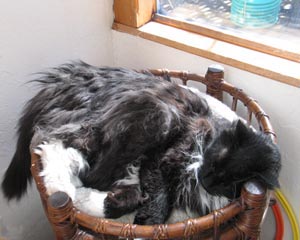Older Cat Adjust to New Home
Pillow, an older cat is adjusting to his new home and life. He's the cat I inherited when my mom died recently. To help make the adjustment as stress-free as possible for him, I brought home the beds and blankets he favored at my mom’s house. Pillow is ignoring them, preferring to shoehorn himself in a small table that I converted into a cat bed. It is circular with a little wicker frame around the edges, barely big enough for him to curl up and sleep in. It also stands about 4 feet high—perfect for viewing the sunroom and the kitchen.
When Pillow isn’t favoring his table-bed, he enjoys sleeping in his carrier. The carrier is always open, available to him and is complete with a comfortable towel and a favorite banana toy. Sometimes he nibbles on treats as he lounges in the carrier. As evidenced from the pictures, Pillow continues to enjoy his meals to the fullest.
Pillow and I have established a routine that includes hobnobbing while I eat breakfast and drink my morning coffee. He sits on a stool next to me, never begging or trying to grab my food. He is a great cat. Part of our morning ritual includes my grooming him after breakfast. When he lets me detangle and de-mat his fur without complaint, he is given special treats—making what could be traumatic into a pleasant and rewarding experience for both of us. The daily grooming sessions are becoming easier every day. Pillow, being a Maine Coon with fur that easily mats, needs to be groomed at least once a day.
Pillow has adjusted well. It is about time to start introducing him to the rest of the gang—one cat at a time. I share my home with Bengals and a large, male Savannah. Bengals and Savannahs are highly energetic cats, who love to spend their days climbing, running and playing. They are not calm, mellow cats. Pillow, a portly cat prefers napping—the exact opposite of my other resident cats.
Although I live with more than one cat, I will concentrate on introducing Pillow to Sudan, my male Savannah. Sudan will have the most difficulty adjusting to a having another male cat in the household. Because the Bengal girls will be a little easier to integrate with Pillow they will meet him after he is introduced to Sudan.
A four phase approach
I will introduce Pillow and Sudan to each other in as stress free way as possible, following the four-phase approach detailed in my book Naughty No More!.The two cats will be encouraged to share mutually enjoyable experiences while they remain separated from each other. Although this may sound a bit strange, cats can start to build relationships without meeting face-to-face.
During the first three phases of the introduction, the cats will be kept separated from each other, Pillow in the sunroom and kitchen, while Sudan and the girls stay in the hall, office and bedrooms. They will only be allowed to switch rooms during the last phase of the introductions.
Cat pheromones
The first step will involve building social skills through doing scent exchanges and basic clicker training. Cats have scent glands on different parts of their body that produce pheromones—some are friendlier then others. The pheromones that are produced by the sebaceous glands on cat cheeks, are sometimes referred to as the friendly pheromones. Cats often say hello by approaching their fave people and rubbing their cheeks and head on them, marking them with their scent. I will use these friendly pheromones, along with clicker training, to encourage good will between Sudan and Pillow.
Clicker training—not just a dog thing
Clicker training is not just for the dogs—it is for all animals, no matter the species. It is a reward-based training technique that has its roots in classical and operant conditioning. Clicker training is based on the premise that animals will repeat behaviors when their actions are immediately reinforced.
It is easy to clicker train cats. Two essential tools are needed—the first is something that the cats love. In clicker-speak, this is called a primary reinforcer. Both Pillow and Sudan are very food motivated, they live for treats. The second tool is a device that always does the same thing whenever it is activated. This will become the secondary reinforcer. I use an iClick clicker. If one of the cats had hearing challenges, I would have used a quick flash from a flashlight as the secondary reinforcer.
After assembling the tools, my next step was to pair the treat with the click so that Pillow would have a positive association with the sound. After the click is paired with the treat, it will become a powerful communication tool that will let the cat know when he is doing a desired behavior. Since Sudan was already a pro with the clicker, I focused on training Pillow.
Pillow was a fast learner. It was easy to pair the click with a treat. I started by clicking once and then immediately giving him a treat. After he inhaled the treat, he looked up at me and I repeated the process, clicking and treating him again. It took ten repetitions until Pillow made the connection between the click and the treat. Years ago, when Sudan was introduced to clicker training, he made the connection between the click and the treat after the fifth repetition. The sound of the clicker is now a powerful communication tool for both cats—alerting them the instance they are doing a desired behavior.
The three of us are ready to start phase I of the introductions.
Help for cat behavior problems is available
For help introducing cats to each other, as well as other cat behavior challenges, contact Marilyn to discuss scheduling a consultation.



Pillow you are a smart kitty learning the clicker connection 🙂
I am so glad to hear that Pillow is doing so well. It sounds like you are successfully helping to fill that void in his life. I hope things continue to go well for you, and I cant wait to read more updates and see more pictures. Thanks for making Pillow just as real for us as he is for you!!!
I have just inherited my father's cat and dog. I'm tryng to figure out how to integrate them with my 3 cats. How did it go for you? Did you share more details about your integration process. So far I have found this an earlier posting. I'm ordering how you did it, specifically. And how is everyone now. thanks.
Hi Sue,
I apologize for not responding before now. I have a 4-5 phase approach which usually works... it can take months, sometimes a year for some cats to integrate. I outline it in my book Naughty No More!
But, it's also important to know that there are some cats who refuse to accept another cat into the household. When that occurs, the best solution is to find the new cat another, fabulous home. It doesn't matter how attached one is to the cat or other circumstances--the priority is the health and well-being of the cats. Unfortunately, that is what happened here. One of my cats did not tolerate Pillow in the house. He threw himself against the door in an effort to reach Pillow. There was one serious incident of redirected aggression. I rehomed Pillow... with the person who adopted Pillow's best dog girl friend, Abby. There were also a couple of other cats who Pillow enjoyed hanging out with at the house. A wonderful home.